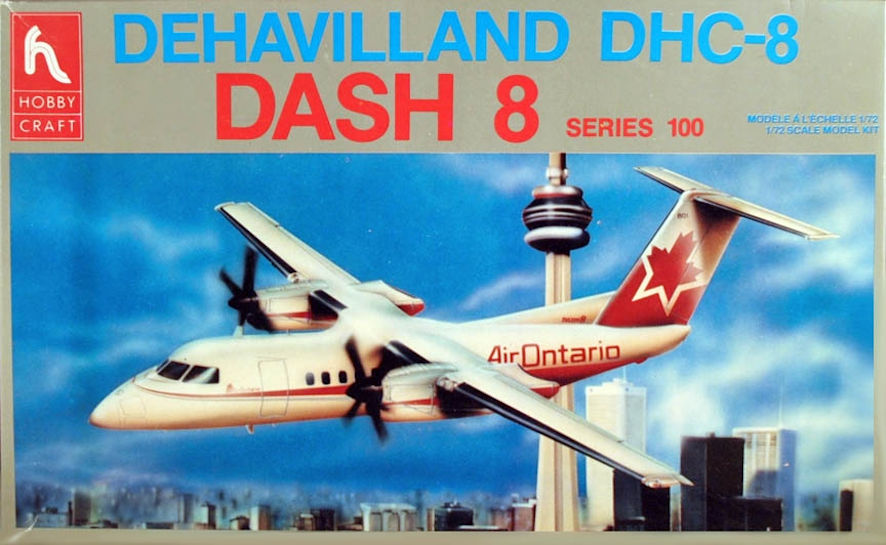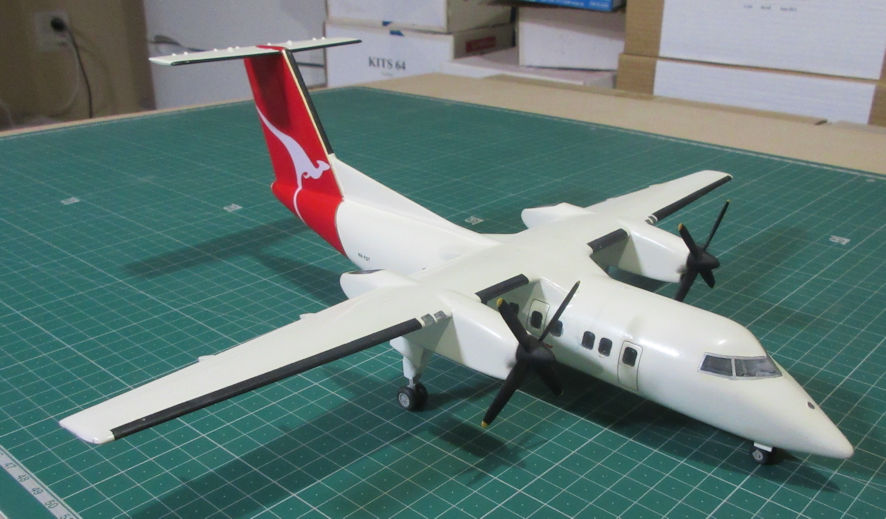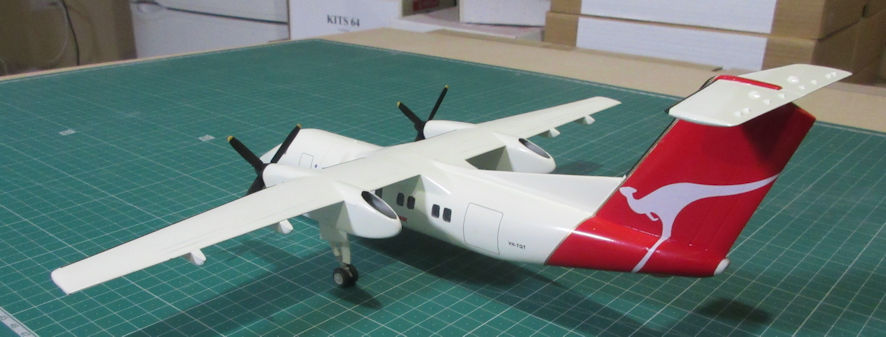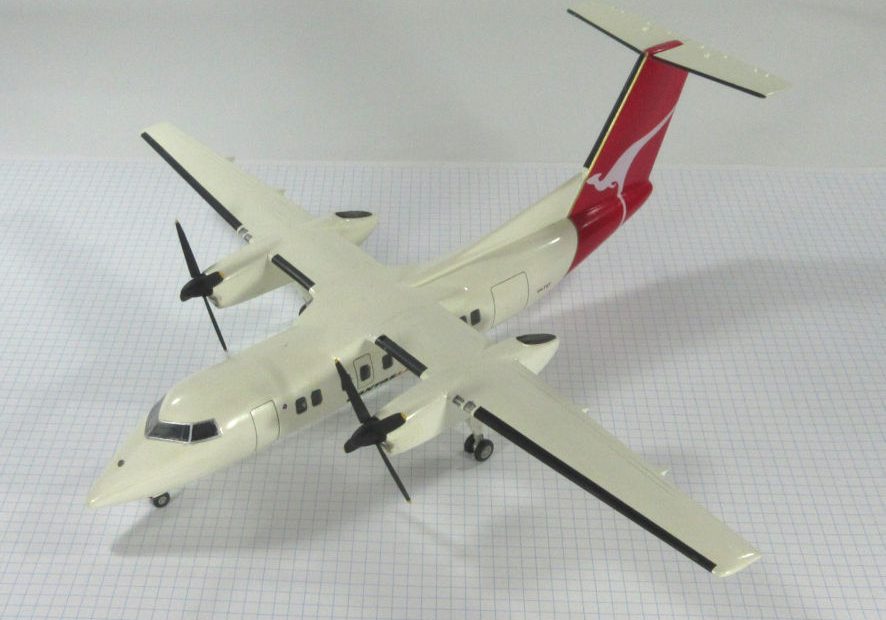DeHavilland Canada designed and manufactured a series of successful general aviation and commuter aircraft, beginning with the late 1940s Chipmunk trainer and including the Beaver, Otter and Twin Otter. In the 1960s it produced the Dash-7, a relatively large fifty passenger four turboprop engined airliner and, in the 1970s, the company’s market research suggested there was a market for a smaller aircraft to fill the gap between the Dash-7 and the DHC-6 Twin Otter. The decision to go ahead with production was made in September 1980 and the prototype made its first flight on 20 June 1983. Four prototypes conducted an exhaustive test program and the Dash-8 was certified in the United States and Canada by the end of 1984.
The Dash-8 was the first of several new, efficient turboprop airliners developed during the 1980s. Others included the ATR 42 and SAAB 340. Together these commuter aircraft became the mainstay of the smaller feeder airlines that served regional areas and, usually through alliances or buyouts, became associated with major domestic airlines.
In Australia Dash-8s began flying with a number of commuter airlines including Eastern Australia, Sunstate flying in Queensland and Southern Australia (originally also called Sunstate but flying in Victoria). When Qantas wanted to set up an airline to compete with Ansett’s commuter airlines it created AirLink that also flew Dash-8s. Many of these airlines also flew other commuter aircraft to suit different routes (I recall being amazed at how ugly Sunstate’s Shorts 360s were) but over time many standardised on the Dash-8. Eventually all these airlines were acquired by Qantas and operated by it to feed into its main domestic services.
In the massive blood letting in the Australian aviation industry that culminated in the collapse of Ansett Qantas merged all its subsidiary airlines into one commuter airline called QantasLink. They continue to do the daily work of carrying passengers and freight on Qantas’s commuter routes across Australia.
The initial version of the Dash-8 was the -100 series, which became the improved -100A in 1990 and the -100B in 1992. Also in 1992 the further improved -200 was introduced with new engines and other developments. A stretched version, the -300, was first flown in May 1987 and delivered from February. It’s wingspan was increased by 1.52m (5ft) and length by 3.43m (11ft 3 in) with a capacity for up to 56 passengers. An even longer version, the -400 that could carry up to 78 passengers, entered service 1999. During the development of the Dash-8 DeHavilland Canada was bought out by Boeing which sold it to Bombardier Aerospace in 1992. Recently the Dash-8 were rebranded as the Q (standing for ‘Quiet’) series, so what had been called the Dash-8-100 is now called the Bombardier Q100.
Although there are plenty of Dash-8s flying in Australia I’ve not had the opportunity to fly in one. I don’t mind it the chance never comes, either. In 1993 I flew in a USAir Dash-8 from Charlotte to Montgomery, Alabama. Montgomery is the capital of Alabama but the only way to get to it from Washington DC by air was in a dilapidated Boeing 737-200 and then this Dash-8. (Still, there are plenty of Dash-8 services flying out of Canberra, so I guess I can’t be too critical.) My only lasting memory of flying in that Dash-8 was that I suddenly understood how sardines feel. Give me a good old F-27 any day of the week.

The only reason you’d make this kit is because, so far as I know, it is the only one available of a Dash-8. Hobbycraft don’t have a very impressive reputation and this kit lives up to their usual very ordinary standard.
There is nothing crisp about the mouldings, there is no engraved or even raised panel lines, the parts are fairly simple and there is nothing in the way of detailing. The cabin is an echoing hollow and the cockpit has some bits and pieces of little merit. If you like detailed undercarriage bays you will be disappointed by the tiny indentations found in this kit. The decal sheets that come with this kit are the most appalling examples you are ever likely to see and I can’t imagine how you would ever use them. Still, it looks more like a Dash-8 than anything else and it’s the only game in town.
I was encouraged to make this model by the Hawkeye decal sheet that allows you to make almost every conceivable Qantas version including AirLink, Eastern, Southern, Sunstate, Qantas New Zealand and QantasLink. There are more registrations on this sheet than anybody could every use. Then, one of our club members was disposing of his kit so it was not expensive enough to put me off, despite its obvious shortcomings. In the end what encouraged me to make it was simple curiosity, could I actually make something reasonable out of this kit?
Putting this kit together is simple and uninspiring. There were the usual gaps and seams that needed attention but a good splash of filler here and there took care of all that. The most difficult problems are the windows, the engine exhausts and the undercarriage. The couple of construction reviews I read of this kit included exhortations to scratch build proper undercarriage bays but it is readily apparent to anybody who is not infected with AMS that this is a totally unnecessary exercise since the aeroplane sits so low on the ground that they are impossible to see.
The engine exhausts are pipes direct from the engines out of the top of the nacelles but the kit does not depict that very well. It turns out that it is very difficult to find photos of the exhausts, but it is important to make them look reasonably realistic because they are easily seen.
The cabin windows are a bit of a concern for several reasons. One is that there is nothing to see on the other side. Another is that masking airliner windows is always a problem. A third is that the kit windows are a little, but noticeably, bigger than they should be. Initially I decided to fill the windows with Krystal Kleer when everything else was done but then I decided that the big windows don’t convey the claustrophobia of being stuck inside one so I decided to cover them over and use the black decal windows that Hawkeye provide. Then, however, I decided I didn’t like that either, and went back to using Krystal Kleer.
Painting is fairly simple, gloss white with a big red tail. It sounds easier to achieve than it actually is, but I’m starting to get the hang of it. The end result looks pretty reasonable, quite attractive really, despite the oversize windows.


Leigh Edmonds
September 2005
